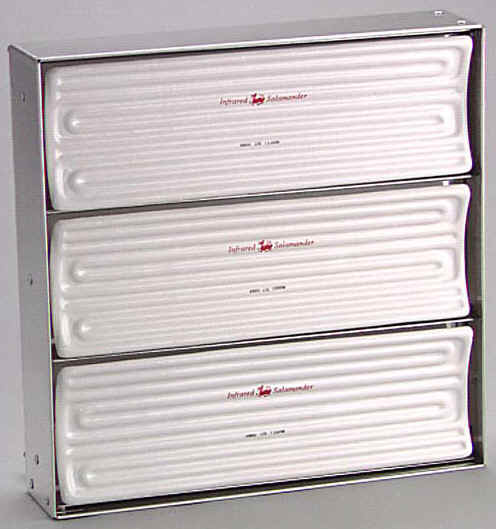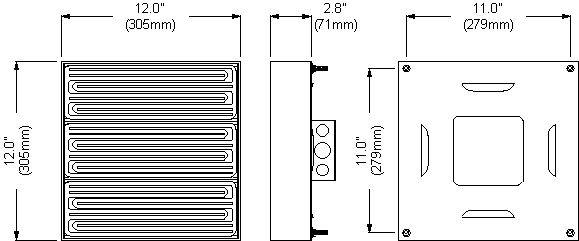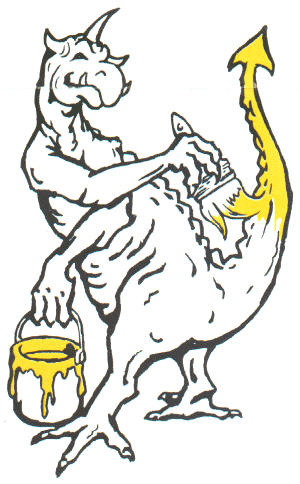InfraredHeaters.com Questions? 1-800-442-2581 |
Our secure online
ordering website: www.MorElectricHeating.com.
|
|
| Home | Products | Accessories | Ordering | Contact Us | Search | ||
InfraredHeaters.com Questions? 1-800-442-2581 |
Our secure online
ordering website: www.MorElectricHeating.com.
|
|
| Home | Products | Accessories | Ordering | Contact Us | Search | ||
Excerpts of Technical Information from Back Issues of The Salamander News
Application Focus: Bottling. November, 1998 issue
Application Focus: Environmental Chambers. March
1999 Issue
Application Focus: Food Applications. April 1999
Issue
Application Focus: Mirrors. May 1999 Issue
Application Focus: Preheating Aluminum and
Steel. July, 1999 Issue
Application Focus: Painting. August, 1999 Issue
So your application requires heat. Now what?
December 2001 Issue
Application Focus
Bottling
The customer
Any company that uses glass bottles for bottling milk, soft drinks, wine,
fruit juice, food products, baby food.
Need
To air dry new or recycled bottles after cleaning without moving air that
could cause streaking, breakage, or the addition of impurities from the surrounding
environment.
Product
Depending on the size of the process, CRP’s (ceramic
radiant panels) are the most efficient and convenient method for a conveyorized or
tracked bottling system. The number and placement of panels would depend on the speed of
the system and the amount of drying required before the bottles reach the next stage of
production.
The CRP panel should be the first suggestion because of its convenient size and availability. After consulting with our engineers to determine the required wattage and voltage, the CRP's can be fitted with (3) three LTE (large trough emitters) and shipped to the customer immediately. Remember, two or more CRP’s can be linked together to form any desired size and shape of heated surface.
Smaller applications could use something as simple as an SWB while more detailed or unusual applications could benefit from a custom designed system.


Advantages
The main advantage of using ceramic heaters for bottle drying lies in the
very nature of infrared heat. The infrared wavelength is absorbed only by objects, not the
surrounding air, so bottles in this case would be receiving the wavelength directly,
causing the heat to be used more effectively than convective methods.
Additional advantages are:
Since infrared energy heats the product directly, drying times would be less, eliminating the need for long pre-heat or cool-down cycles.
Because there is no blowing or movement of air, streaking and spotting would be eliminated, and the entire system could be kept dust and contaminate free. This radiant method of drying would cause no movement to the bottles that could cause breakage, there would also be no intense heat changes that could result in cracking.
Ceramic heaters would aid in the sanitary requirements of the bottling industry being non-corrosive, splash resistant, and having a surface able to be cleaned.
Selling Salamander ceramic heaters to any of the bottling industries may depend on their existing application and whether or not drying is required. Even if no heat is currently used, a good salesperson could still suggest the possibility of incorporating infrared heat into their process for the purpose of time savings and the other advantages mentioned above.
The bottling industry is a challenging and unproven market for ceramic infrared heaters. If any reader knows of a bottler currently using ceramic heaters or you are successful in selling to them, please contact The Salamander News as a means of sharing the information.
Application Focus:
Environmental Chambers
In our series of articles on application focus, keep in mind that there is a difference between proven applications and potential applications. The potential for using ceramic infrared heaters is limitless and many markets are waiting to be tried and tested. A good rule of thumb to use is that anywhere a gentle, easily controlled heat is needed, there could be a place for ceramic infrared emitters.
The wavelength emission characteristic of ceramic heaters is what could make them a possible choice for use in environmental chambers. Life cycle testing can be affected by moving air which could contaminate the required sterile conditions. Some testing is done with the sole purpose of measuring the effect of infrared energy on a product. While infrared heaters would not be effective in ovens where an even temperature gradient is needed, there can also be applications where spot testing, accelerated life cycle testing, or the effects of temperature difference is required that would be very suitable for using ceramic heaters.
The potential is great for specialized testing facilities, or possibly environmental vacuum systems where convection type heat is an impossibility. As with many other markets, the environmental chamber industry is virtually unexplored territory for ceramic use. It is up to all of us to make these industries aware of ceramic infrared heaters and their possible potential.
Application Focus:
Ceramic Elements and Food Applications
This issue of The Salamander News is designed to make you hungry. Not for food, but for the variety of food applications that have yet to discover the advantages of using ceramic elements. One thing I love about this product is the endless possibilities for its use. Ceramic elements are incredibly adaptable to even the most unusual applications. The food industry provides a huge market of possibilities through restaurants, from fast food to fine dining, commercial food producers, and food equipment manufacturers. They can also be used in a variety of processes as listed below.
Baking
Ceramic elements have been used for making ovens for many years. Even though the concept is the same, they have not been used for baking food. Existing oven adaptation might be difficult, but new oven construction is a unique possibility. The oven would function with the same combination convection and radiant heating pattern as traditional ovens, but with the added energy efficiency ceramic heaters offer. Their clean and washable ceramic surface are an added benefit for required hygienic conditions. Conveyor oven systems are even more suitable for ceramic use and more conducive to retrofit.
Warming
Food warming is already a popular application from fast food restaurants such as Kentucky Fried Chicken to exclusive fine dining kitchens as found in the Grand Plaza Hotel in Grand Rapids, MI. They provide a gentle, even heat without fear of corrosion or breakage. The manufacturers of food equipment also need to be made aware of the ceramic heater option and its benefits.
Dehydrating
Research and development work done on an apple dehydrating application proved ceramic heaters to be both effective and efficient. Elements may be used in small single unit machines or large conveyor systems. Along with food dehydration, are agricultural applications such as grain drying.
Broiling
A ceramic element certainly doesn't look like a traditional broiling element but it can have a high enough watt density to function like one. Ironically, the shape of a ceramic element provides an advantage in broiling. It can provide much more even heating over a wider area. The HSE (square element) is a good example of the surface area coverage as opposed to a tubular element. Using one or more HSE elements in a small table top broiler or larger commercial broiler could provide obvious benefits.
Toasting
Toaster ovens have as much of a potential for ceramic heater use as broiling. The cleanliness of ceramics can be a strong selling point for both applications since one causes spattering and the other crumbling. The ease of cleaning a ceramic element can prevent grease or food build up that can interfere with heating effectiveness, smoking or burning, and harbor harmful bacteria.
Melting
Ceramic heaters are ideal for a melting operations such as chocolate or cheese. Their gentle, even heating can be easily controlled for such heat-sensitive procedures.
As with most applications, no matter what the market, ceramic elements remain the unknown alternative. Selling must sometimes take a backseat to educating the customer about, what they are, how they work, the differences between them and the heat source they commonly use, and highlighting the benefits they can provide.
It's difficult to get customers to try anything new or make a change. They must have proof or a good presentation showing them the logic behind the change required. The basis for selling ceramic elements must be technology oriented. A customer must understand how they can benefit, if not immediately, then over time. Don't start, or stop, with price. A knowledgeable salesperson should be able to point out the long term cost savings created by more effective production, improved product quality, and overall efficiency.
Application Focus:
Mirrors: An Application Worth Looking Into
Surprising applications come before us every day. A little investigation can sometimes open the door to new and untried possibilities. The idea of using ceramic infrared heaters with glass applications has intrigued all of us. Annealing and tempering glass would require too high of temperatures to use ceramics, but curing the paint used on the back of mirrors is a perfect application.
Looking back in our files, we found that we had in fact, created an oven design for a manufacturer in India for the purpose of pre-heating and curing the paint on the back of mirrors. The oven they requested had to be large enough to accommodate a mirror 2600mm in width. Two ovens were actually needed, one for pre-heating and the second for curing. In both ovens, a series of CRP panels containing three LTE elements at 1800 watts each was suggested to meet the desired wattages of 40kw and 100kw.
The customer had first requested quartz heaters. We pointed out that ceramic heaters are 96% efficient in converting electricity into infrared energy compared to the quartz efficiency of 85%. Ceramic infrared operates in the medium to long range wave length of the infrared spectrum with 75% of the energy around the 3.0 micron wave length. Quartz operates in the short wave length of the infrared spectrum with 70% of its energy in the .9 to 2.0 micron range. Most paints have an absorption rate at about 3.5 to 4 microns, making ceramic infrared the most efficient radiant heating element to use.
There are many other techniques now done with glass and mirrors that may require pre-heating, drying, curing, or baking and a wide variety of markets using them. Many can be found on the internet or in your local yellow pages. All it takes is one investigative phone call to open a door to a new ceramic infrared customer.
 Application
Focus:
Application
Focus:
Preheating Aluminum and Steel
The preheating of metals is often necessary for improving processes of painting, bonding, forming, and the stamping of metal. The low emissivity of metal can make preheating difficult. The process can be more effectively done if the metal is coated or painted before being heated.
If the metal is coated, ceramic heaters can be very effective as an infrared heat source for conveyorized systems. Using ceramic emitters in oven applications enhances the heating by adding infrared heat to the convection process.
Industries that may require the preheating of metals are, furniture manufacturing, aerospace, building products, or automotive. Plastics has replaced metal in so many applications, that identifying end products containing metal may be the best way to pursue potential metal preheating markets.

Application Focus:
Painting
The market of paint application is so diverse that it’s easy to understand why it is virtually unexplored for the use of ceramic heaters. To simplify a complex subject, I have separated the main industries using paint application according to various mediums: steel, aluminum, and wood. Plastics, textiles and powder coating will be reviewed separately at a later date.
These three mediums in themselves create an overwhelming number of possibilities. If we consider why customers would need heat for their painting applications, two main reasons stand out: to dry them quickly, or to dry them carefully. The need to dry products quickly is usually required by large companies mass producing their product. Time is money to them and they usually have space considerations forcing them to move products quickly. This means that sales potential can be found at any large company that paints any steel, aluminum, or wood parts in their manufacturing process. Call on them. Look at their process, then show them how they can same time, money, and space by using the efficiency of ceramic elements.
Businesses that are concerned with drying "carefully" will most often be small companies that are concerned with detail such as car detailers, or woodworking shops. We had an e-mail inquiry recently for a need for infrared heat for drying sculptures. Though you may not want to take the time to call on every small shop in town, a well targeted flyer might be sent out.
One of the biggest advantages of using infrared heat for paint drying is the elimination of moving air which can cause streaking, uneven drying, and bring dust particles into the paint. The other advantage is speed as noted in the following comparisons:
PRIMER |
STOPPER |
FILLER |
FINISH |
||||
Air dry |
Infrared |
Air dry |
Infrared |
Air dry |
Infrared |
Air dry |
Infrared |
20/30 min. |
4/5min. |
6/12 hrs. |
20 min./2 hrs. |
20 mins./3 hrs |
4/20 mins. |
20/50 mins. |
4/10mins. |
This efficiency can create up to an 80% improvement in drying time.
Caution must always be taken when applying heat to painted substances due to the potential for combustion. Always be aware of the content of the paint being used. Make sure the system provides for adequate ventilation. The wattage and distance from the product must correlate to the paint consistency and strength. These questions must be asked of the customer’s engineering or maintenance staff, always making sure that any potential hazards are understood as well as the potential benefits.
Opportunities abound for the aggressive salesperson or the company owner looking for ways to increase their bottom line. All it takes is a confident understanding of the function and benefits of ceramic heating elements and communicating that information to your sales objective.
December 2001 Issue:
So your application requires heat. Now what?
Written by: Deitz Kracker
If first you determine that an application requires heat, then you narrow that down to “electric” heat, and finally decide that “infrared” heat would be the best possible choice, you have only just begun to make the “sale”. Requiring the heat is one thing, applying the heat is quite another. It’s easy to sell replacement elements, but the majority of salespeople shrink back in uncertainty when it comes to the word “layout”.
It’s fun to introduce ceramic heating elements to an interested customer who may have not heard of them before. “It’s the latest thing since sliced bread” you may proudly convince them. They are interested, they bite, they are hooked, you are happy and pleased with yourself, and then they say, “But how can I use them in my application?”
“Who cares!”, you think unto yourself. “Just buy the elements! That’s not my problem, figure it out for yourself!” Unfortunately, it “is” your problem. And equally unfortunate, for the average salesperson, understanding layout is the key to selling ceramic infrared elements. I know I have covered this before. The November 2000 issue on “Sizing & Layout” was a huge flop and an even bigger indication that there were problems in the field. I have given workshops and seminars on the subject, but the fear and uncertainty still remain and the question of layout is most often answered with a call to Mor Electric.
The majority of us are not electrical engineers, and most of our customers are not either. It is difficult to explain something to our customer that we, ourselves, don’t fully understand. Complete sizing and layout takes a great deal of time and effort on the part of our staff. They may even resist doing it if they feel it lacks potential as a sale. A typical request might be: My customer wants to dry fruit using infrared heat. How many elements would be needed and how would he lay them out?
This type of request, although it may be well intended, will get a negative response. Too much information is missing and too much work is involved to follow through. It’s like any other form of writing. If you want a response, make sure the request is interesting enough to get their attention. It would help if you, the customer or distributor, presented the request with the “groundwork” included. A screening form is needed to quickly assess applications in terms of feasibility. Using this form could allow faster response time in the evaluation of applications.
Please copy and save the Application Request form on the reverse side and use it when submitting any request for sizing and layout.
![]()
Request for Infrared Application Layout and Design
Please fill out this form as accurately as possible and send it to Mor Electric Heating:
e-mail (sales@InfraredHeaters.com) or fax (616-784-7775)
Name ________________________________________________ Phone ___________________________
Fax ________________________________ E-mail _____________________________________________
Circle one: R&D Project New Application Retrofit
1. What is the application?_______________________________________________________________
2. Circle one: Batch Oven Conveyor Isolated Heater
3. What is the product?_________________________________________________________________
4. What do you want the infrared heat to do?________________________________________________
5. Heated area or product dimensions:
Height_________ Length________ Width__________
Weight_________ Color__________
6. If drying, total weight of moisture content in grams (if known)____________
7. Starting temperature?____________________
8. Temperature required?___________________
9. Application cycle time?__________________
10. Desired power supply: (circle one) 120V 240V 480V Single phase 3-Phase Other___________________
11. Maximum amperage available?:_____________
12. Will a control be needed?__________
13. Desired Price Range: 0-100 100 to 500 500-1000 1,000+
|
We are a distributor of infrared heaters. Always consult manufacturers installation instructions for proper installation of the products or systems shown on this website. © Copyright 1999-2019 Mor Electric Heating Assoc., Inc. MOR
ELECTRIC HEATING ASSOC., INC. |